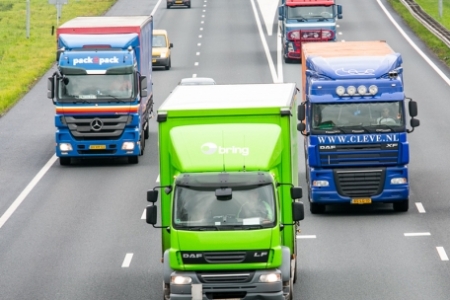For trucks, the following vehicle measures have been taken: open side shields, blind spot mirror, 90 km/h speed limiters, presence and usage of seat belts, retroreflective contour marking, Automatic Emergency Braking (AEB) system and Lane Departure Warning (LDW) system. The effective date and effectiveness of the measures are presented in Table 5.
|
Measure |
Legislation |
Effectiveness |
|
Open side shields |
1998: Article 5.3.48 in [3] |
A side shield may prevent vulnerable road users from sliding underneath the rear wheels of the truck or (semi)trailer. Not much is known about the effect of side shields on road safety, but according to estimates a positive effect is expected [44]. |
|
The presence and use of seat belts is mandatory for occupants of trucks and delivery vans |
EU directive 2003/20/EC [45] |
Not much is known about the road safety effect of seat belt use among drivers of trucks and delivery vans. These drivers use seat belts less often than car drivers [46] [13]. It is to be expected that increasing seat belt use among occupants of trucks and delivery vans will lead to fewer severe injuries. |
|
Introduction blind spot mirror |
1 January 2003 [47] |
The decrease of the number of road deaths due to blind spot crashes in the first few years after the introduction of the blind spot mirror may be caused by this introduction and the associated publicity, but also by coincidental fluctuations [32]. Not much is known about the road safety effect of the front-view mirror, the more convex wide-angle mirror and the larger close-proximity mirror. |
|
Introduction of front-view mirror, more convex wide-angle mirror and larger close-proximity mirror |
EU-richtlijn 2007/38/EC [48] |
|
|
Mandatory 90km/h speed limiters for N2 and N3 vehicles |
2005: Article 5.3.15 in [3] |
Lower speeds decrease both crash rates and crash outcome severity (see SWOV fact sheet Speed and speed management. |
|
Retroreflective contour marking of trucks with a maximum mass exceeding 7.5 tonnes and trailers exceeding 3.5 tonnes |
2008: EU directive 2007/35/EG [49] 2011: retrofit trucks that are issued with a registration number for the first time (in accordance with [49]) |
Research into the effectiveness of applying retroreflective contour marking to existing trucks (retrofitting) shows that, in the Netherlands, this measure will save an annual maximum of three road deaths [50]. |
|
Automatic Emergency Braking (AEB) system mandatory for trucks |
2013: EU regulation 661/2009 [51] |
Although a positive road safety effective of AEB has been proved for cars [52], there are no exact figures of the road safety effect of AEB for trucks. Several studies theoretically estimate a positive effect of AEB for trucks [53], although practical tests at a test track show that current AEB implementations for trucks are not always reliable in the timely detection of obstacles [54]. |
|
Lane Departure Warning (LDW) system mandatory for trucks |
2013: EU regulation 661/2009 [51] |
Research shows that trucks with an LDW system have a 1.9 smaller risk of getting involved in sideswipe collisions, single vehicle crashes and head-on collisions due to lane departure [55]. |
Table 5. Vehicle measures taken to increase road safety for trucks and delivery vans.
Possible new vehicle measures
Blind spot detection and warning systems (BSW) may alert truck drivers to other road users in their blind spot [55]. Collision avoidance systems (such as Advanced Cruise Control) may also help prevent crashes, but may distract drivers as well [57], also see SWOV fact sheet Intelligent transport and driver assistance systems (ITS and ADAS).
In Great Britain, a method has been developed to assess direct vison (without using mirrors) of vulnerable road users from the cabin [58]. to reduce the number of blind spot crashes. A truck may score zero to five stars, the latter corresponding to the best possible direct vision of vulnerable road users. The mayor of London has applied this standard by only allowing N3 trucks, from 26 October 2020 onwards, access to London when scoring a minimum of one star. From 2024 onwards, trucks should have at least three starts to be allowed to enter London [59]. This measure forces manufacturers to build trucks with improved direct vision, for example by fitting the motor block differently which lowers the truck driver’s seat and the position of the side windscreens.
